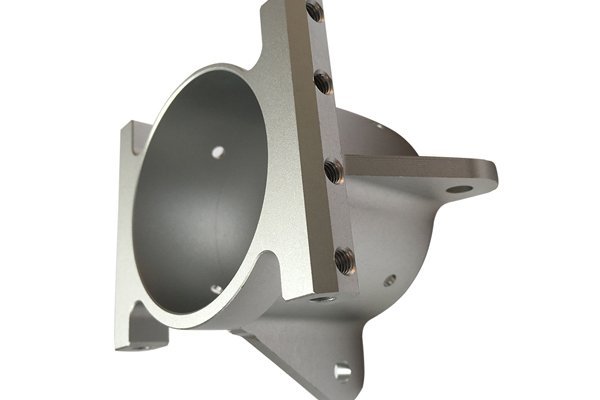Did you know that aluminum is the most widely used non-ferrous metal in the world? In 2022 alone, over 60 million tons of aluminum were produced globally, underscoring its versatility and demand across various industries. As manufacturers face increasing pressure to deliver high-quality products at competitive prices, the need for efficient and accurate production methods becomes crucial. This brings us to the topic at hand: how CNC machining can enhance the production of custom aluminum parts in large batches.
Understanding CNC Machining
CNC (Computer Numerical Control) machining is a manufacturing process where pre-programmed computer software dictates the movement of factory tools and machinery. This technology can control a range of complex machinery, from grinders and lathes to mills and 3D printers. Crucially, CNC machining allows for the automation of intricate manufacturing processes that would otherwise require excessive manual labor, thus enabling the high-speed production of precision parts.
The Role of CNC Machining in Aluminum Production
Aluminum is favored in many sectors for its lightweight properties, corrosion resistance, and malleability. However, manufacturing custom aluminum parts in large batches can be challenging. Traditional manufacturing techniques may not provide the precision or adaptability required to meet varying specifications. Here’s where CNC machining comes into play.
CNC machining is capable of producing aluminum components with high accuracy and repeatability. The ability to produce parts based on precise digital blueprints allows manufacturers to meet stringent quality requirements while maximizing production efficiency.
Benefits of Using CNC Machining for Custom Aluminum Parts
One of the most significant advantages of CNC machining is its ability to produce parts with exceptional accuracy. A CNC machine precisely follows the detailed instructions provided by CAD (Computer-Aided Design) software, ensuring that each part is created to exact specifications. This precision is crucial when producing complex geometries that are characteristic of custom aluminum parts.
CNC machines operate continuously and can produce parts much faster than manual machining techniques. The automation of cutting processes means that manufacturing can occur around the clock, effectively increasing output and allowing manufacturers to meet high-demand production schedules.
CNC machining facilitates rapid prototyping and adjustments. If a design needs to be altered, changes can easily be made in the software, allowing manufacturers to produce different parts without the need to invest in new tooling for every design iteration. This flexibility is especially beneficial for custom aluminum parts, which often require variations in design.
While the initial investment in CNC machinery may be high, the long-term savings can be substantial. Greater efficiency translates to lower labor costs, reduced waste, and less time spent on each project. For businesses that require large batches of aluminum parts, the savings associated with using CNC machining can be significant.
CNC machining inherently promotes higher quality through its capacity for precision and consistency. Each component produced through CNC machining undergoes rigorous quality checks to ensure it meets the set specifications and finishes. This level of quality control is especially critical in industries such as aerospace and automotive, where failure can be catastrophic.
CNC machining effectively minimizes waste through precise cutting techniques. Advanced programming allows for optimized nesting of parts, ensuring that minimal raw material is discarded during the production process. This can lead to significant cost savings, particularly when working with expensive materials like aluminum.
The CNC Machining Process for Custom Aluminum Parts
To fully appreciate the advantages of CNC machining, it is essential to comprehend the manufacturing process that brings these benefits into play.
Step 1: Designing the CAD Model
Every project begins with a design. Engineers and designers create a 3D CAD model of the desired aluminum part, including precise dimensions, tolerances, and surface finishes. This model serves as the blueprint for the CNC machine. Various CAD software programs are preferred, such as AutoCAD, SolidWorks, and Inventor, each offering unique strengths.
Step 2: Preparing the CNC Program
Once the CAD model is ready, it’s converted into a CNC machine language format using CAM (Computer-Aided Manufacturing) software. This translation process involves creating G-code, which instructs the CNC machine on how to move, cut, and shape the aluminum material.
Step 3: Setting Up the CNC Machine
Before the manufacturing process can commence, the CNC machine must be set up. This involves securing the aluminum raw stock in the machine’s workholding fixtures, calibrating cutting tools, and inputting the G-code into the CNC machine.
Step 4: Machining Process
With everything prepared, the machining process begins. The CNC machine follows the programmed instructions to cut, mill, or turn the aluminum parts. Depending on the complexity of the part, multiple operations may be required, including drilling, milling, or turning.
Step 5: Quality Assurance and Finishing
Once the machining is complete, each part undergoes stringent quality assurance. Advanced inspection techniques, such as CMM (Coordinate Measuring Machines), are often utilized to ensure each component adheres to the specified tolerances. Following quality checks, parts may require additional finishing processes, such as anodizing, to improve surface quality and durability.
Industry Applications of CNC Machining for Custom Aluminum Parts

CNC machining finds application in a multitude of industries, emphasizing its versatility in producing custom aluminum parts. Here’s a closer look at some key sectors that benefit from this technology:
Aerospace
The aerospace industry demands precision-engineered components that can withstand extreme conditions. CNC machining allows manufacturers to produce lightweight custom aluminum parts, such as brackets, housings, and structural components, with tight tolerances essential for safety and performance.
Automotive
With the continuous push for fuel efficiency and performance improvements, the automotive industry relies heavily on aluminum parts. CNC machining helps manufacturers produce everything from engine components to body panels with high strength-to-weight ratios that enhance vehicle efficiency and performance.
Electronics
As electronic devices become smaller and more complex, the demand for custom aluminum enclosures continues to rise. CNC machining offers the precision necessary to produce intricate designs that protect electronic components while maintaining aesthetic appeal.
Medical Devices
In the medical field, precision is paramount. CNC machining allows for the production of custom aluminum parts that meet stringent regulatory standards, including surgical instruments, implants, and devices that require meticulous engineering.
Consumer Goods
From kitchen appliances to fitness equipment, many consumer goods contain custom machined aluminum parts. CNC machining enables manufacturers to create aesthetically pleasing, durable products that meet consumer demands in a competitive marketplace.
Challenges in CNC Machining Custom Aluminum Parts
While the benefits of CNC machining are significant, certain challenges necessitate consideration:
Investing in CNC machinery can be expensive, especially for small manufacturers. The cost of purchasing machinery, training staff, and software applications poses an entry barrier for many businesses.
CNC machines require regular maintenance to ensure optimal performance. Companies must account for maintenance schedules and costs in their operational budgets to avoid machinery downtime.
Despite the automation facilitated by CNC technology, skilled operators are essential. There is often a skills gap in the industry, making it challenging to find qualified personnel to run and maintain CNC machines effectively.
Solutions for Common CNC Machining Challenges
Investing in Training
To bridge the skills gap, manufacturers should invest in comprehensive training programs for their employees. This training can help staff elevate their skills in CAD design, CNC operation, and quality assurance processes.
Embracing Technological Advancements
Emerging technologies, such as AI and IoT (Internet of Things), can help optimize CNC machining processes. By integrating smart technologies, manufacturers can gather data, analyze performance, and make informed decisions to improve production efficiency.
Collaborating with Skilled CNC Providers
Small manufacturers can establish partnerships with experienced CNC service providers to meet their production needs without the high costs associated with purchasing machinery. Outsourcing CNC machining allows companies to focus on their core competencies while leveraging specialized knowledge and equipment.
In conclusion, CNC machining plays a pivotal role in revolutionizing the production of custom aluminum parts in large batches. Its ability to enhance precision, speed, flexibility, and cost-effectiveness positions CNC technology as a formidable ally for manufacturers across various industries.
By leveraging CNC machining, manufacturers can navigate the complexities of modern production demands while maintaining high-quality standards. The detailed process of designing, programming, and executing CNC machining demonstrates its ubiquitous applicability and importance.
As we move further into an era marked by technological advancements and globalization, understanding the vital role of CNC machining in manufacturing custom aluminum parts will become increasingly significant. Adapting to these advancements not only equips businesses to thrive in a competitive landscape but also holds the potential to redefine the very nature of production itself.
Embrace the change—technological evolution is the key to sustainable success in custom aluminum part production. Consider CNC machining not just as a tool, but as a transformative approach to manufacturing that can redefine your business’s future.






